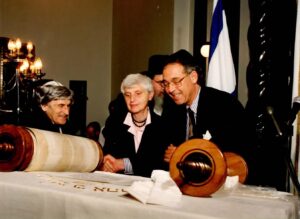As a congregation, we can be very proud of our collection of Torah Scrolls. Just how we came to have so many scrolls is a mystery but the question of why we needed the scrolls is easy to understand.
The first question is easy to answer. It is easy to imagine a time early one when there was not a single Torah scroll at all. I am sure no one thought about buying a Torah and donating it to the synagogue they did not know existed until they came to St. Catharines and realized that one was lacking. No one is alive to know the history of any of the scrolls and no one has bothered to research any of their provenance. This writer is pretty sure that one of the Torah scrolls was donated by Harry Rubin because his name is written on the end of one of the scrolls, around the post. We have been led to believe that it was actually donated by the Offstein and the Rubin family. Perhaps as people read these little history vignettes, we will be provided with historical details by members of some of the families that came to live in St. Catharines. We do know that the last Torah donated to the congregation came from the generous pocket of Leo and Ruth Possen, in honour of the Six Million Jews including their own family members who had perished in the ovens of the Holocaust. The picture below was taken on the day the writing of the scroll was completed. The Sofer came to St. Catharines along with the almost completed scroll. Member families donated to participate in the completion of the scroll. They came up to the bima one family at a time to witness letters being completed.
As to the answer to the second question, why so many, anyone who has choreographed services for an entire year on the bima knows that just having one Torah scroll is never enough if more than one is possible. To help the reader understand, at Simchat Torah, we are supposed to finis the reading of the Torah and begin again on the same day, in the same service. That would or could mean sitting and waiting to roll a single Torah from the end of the scroll all the way back to the beginning. I supposed in an earlier time, congregations would wait patiently, but can you imagine that patience today at a service during the day? So having one Torah at the end and another one already at the beginning is a big help. Then there are the days when we have to read from the parsha in one place and a maftir from another, all the while waiting to find the place in a single scroll. Most congregations are lucky enough to have at least three of four scrolls, and just for the record, the last Torah was commissioned for $25 000.00 dollars.

